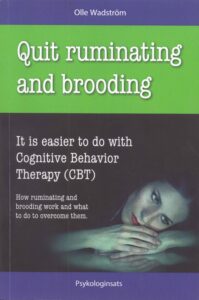 Discomforting or intrusive thoughts can have varying appearances and contents. They can evoke discomfort by frightening and worrying us, they can lead to anxiety, irritate, provoke, confound us, make us insecure, and they can make us feel hurt, wronged or insulted. Many people think in terms of images or scenarios, which does not make any difference for our line of reasoning.
Discomforting or intrusive thoughts can have varying appearances and contents. They can evoke discomfort by frightening and worrying us, they can lead to anxiety, irritate, provoke, confound us, make us insecure, and they can make us feel hurt, wronged or insulted. Many people think in terms of images or scenarios, which does not make any difference for our line of reasoning.
The thoughts that evoke discomfort can have many different types of content. Their common denominator is that they evoke uneasiness and discomfort, more or less automatically. In the case of OCD, discomforting thoughts are also referred to as “emotion-thoughts”.
Below are a few examples of discomforting thoughts:
Catastrophic thoughts
What if I fail my exam!
Am I going insane?
Mother might die.
I am surely going to get fired now.
The kids might get hit by a car when they are walking to school.
What was that look that she gave to Nisse when I protested?
What if I have cancer?
Does he mind me speaking, since he looked at me that way?
They can tell that I am nervous.
What if I do not find anyone to share my life with?
Doubt and insecurity thoughts
I wonder what he meant by asking me about this?
Did I hit someone when I was driving in the dark?
Was she sneering at me when I was speaking?
What if I forgot to lock the door?
Did I do the wrong thing when I…?
Does he not love me anymore?
Existential insecurity
What is the meaning of life?
Is there a God?
Has my life been in vain?
Will life never be more than this?
What happens after death?
Am I wasting my life?
Self-accusation thoughts
Maybe I hurt her when I said that I did not want to?
They probably did not understand what I meant. What if something goes wrong because of me, and they get hurt?
Did he really understand what I meant?
What if she thought that I was negative and criticizing when I said…?
I wonder if he resented that?
Is Pelle sad because I said that?
How could I be so stupid that I…?
I am a bad mother and I do not have time for the things I need to do at work either.
Comparing thoughts (along with jealousy thoughts)
Which car is the best, and which one should I choose?
Should I really get a new job?
They probably just think that I am a dork. They despise me.
I am not as good as they are.
She does not love me as much as I love her.
She is always better than me.
I am always the worst.
He is much smarter than me.
Other people always get the best, while I always get the worst.
Why is he just looking at her?
A characteristic of the discomforting thoughts is that they trigger a feeling of worry, uneasiness, doubt, or some other unpleasant feeling.
This is an exerpt from the book Quit Ruminating and Brooding by Olle Wadstrom. Comments and discussions are encouraged.
The book is available in two similar versions. Please choose the green and black version. AuthorHouse (the white version) keep my legally earned royalty to themselves, because of a self-imposed rule.

